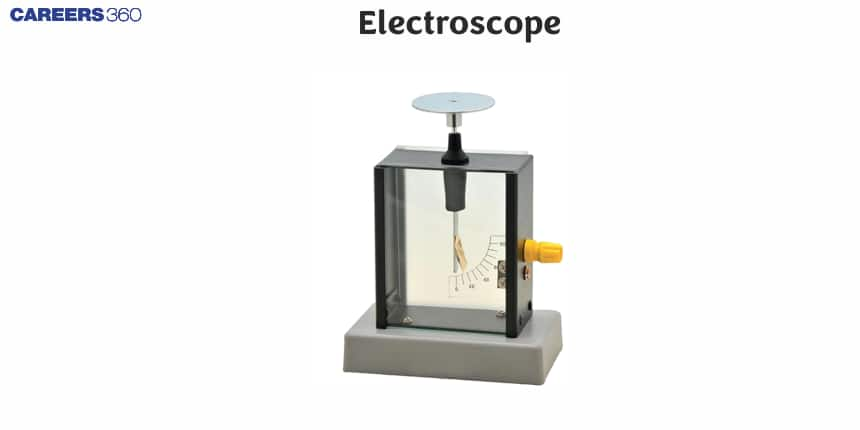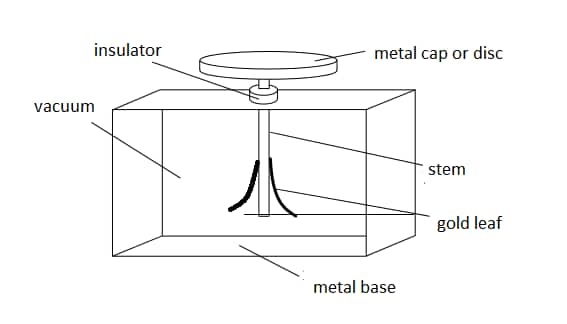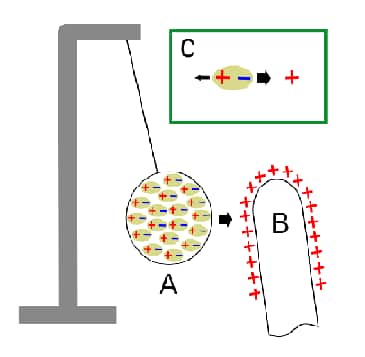Electroscope - Definition, Types, FAQs
An electroscope is an instrument used to detect the presence of charge and its nature. A gold leaf electroscope is an example of a widely used electroscope. They are used for determining the nature of electric charges, to find the presence of an electric field, and also to differentiate conductors and insulators. In this article, we will discuss what is electroscope, what is gold-leaf electroscope and pithball electroscope, the structure and working of electroscopes, electroscope diagrams, and the uses of electroscopes.
This Story also Contains
- What is Electroscope?
- Types of Electroscope
- What is Gold-Leaf Electroscope?
- What is a Pith Ball Electroscope?
- What is the Use of an Electroscope?
- Limitations Of Microscope

What is Electroscope?
Electroscope definition: A simple electroscope is an instrument used to detect the presence of charge and its nature. Electroscope works on the principle of repulsion of like charges and electrostatic induction. When a charged body induces a charge on the part of the electroscope, the leaves spread apart due to repulsion which indicates the presence of a charge.
Types of Electroscope
There are two types of electroscopes.
- Gold leaf electroscope
- Pith-ball electroscope
|
Related Topics, |
What is Gold-Leaf Electroscope?
It is a type of electroscope used to detect and measure the presence and magnitude of electric charges on a charged body. The gold-leaf electroscope diagram is given below:

Explain the Working Of Electroscope - Gold Leaf Electroscope
To determine the nature of the charge of a body, an electroscope has to be charged positively or negatively. If the electroscope is positively charged, then its leaves are divergent. The object to be tested is bought slowly in touch with the disc. If the divergence between the leaves gets increased then the object is positively charged. If the divergence gets decreased then the object is negatively charged. As we know, opposite charges attract each other, and the same charges repel each other. Due to this property of charges gold leaves show such a phenomenon.
The nature of the charges would just be the opposite if we initially started with a negatively charged electroscope. If the object was uncharged then also it will diminish the divergence to some extent, so it is not easy to determine the nature of the charge of the body. If the test object is opposite in nature to the electroscope. However, the increase in divergence of the leaves of the electroscope gives us an indication of the nature of the body.
What is a Pith Ball Electroscope?

A Pith ball electroscope is made up of one stand and one small nonconducting ball. Sometimes there can be more than one ball also. If an object is taken closer to the balls then the balls get attracted towards that object. By this phenomenon, we can conclude that the object is charged. Pith ball electroscope uses the induction nature of charge as its working principle.
Explain the Working of Electroscope- Pithball Electroscope
The components of the pith ball electroscope are
- pith ball
- non-conductive string
- support structure
The pith ball is electrically neutral in its initial state. The electrostatic induction occurs when a charged body is bought near the pith ball making the charges in the pith ball to redistribute. The ball is attracted to the positively charged rod. The pith ball has the same charges as the charged body after making contact. The pith ball moves away from the body due to like charge repulsion. Now when a neutral body is brought near the pith ball, it attracts the body due to polarisation.
What is the Use of an Electroscope?
- An electroscope is used to determine the nature of the charges.
- It detects the presence of charge in a body.
- The strength of the two charges can be compared by using electroscopes.
- It is used to determine the presence of electric field
- It is used to differentiate between conductors and insulators
Limitations Of Microscope
- Resolution is limited
- High maintenance
- More expensive
- Limited field of view
- Magnification restrictions
Also read:
Frequently Asked Questions (FAQs)
John Canton invented the pith-ball electroscope.
In the year 1754 the pith ball electroscope was invented.
The pith-ball electroscope uses the induction characteristic of charge.
Abraham Bennet invented the gold leaf electroscope.
1787 the gold leaf electroscope was invented.
The attraction and repulsion characteristic of charge is used in the gold leaf electroscope.
Following steps are followed to make an electroscope:
A glass container is taken and a metal coil is introduced inside it.
Two metal plates are fixed to the metal coils present in the container.
Another end of the coil is kept in contact with the charged body.
This setup will help in finding the charge present.
British physician William Gilbert invented the electroscope.
In the year 1600 the electroscope was invented.